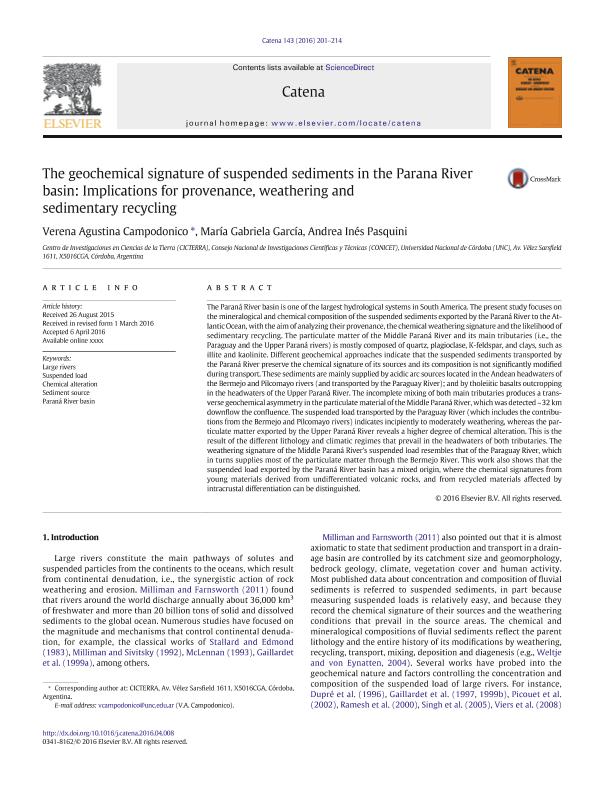Mostrar el registro sencillo del ítem
dc.contributor.author
Campodonico, Verena Agustina

dc.contributor.author
Garcia, Maria Gabriela

dc.contributor.author
Pasquini, Andrea Ines

dc.date.available
2018-05-07T15:11:12Z
dc.date.issued
2016-08
dc.identifier.citation
Campodonico, Verena Agustina; Garcia, Maria Gabriela; Pasquini, Andrea Ines; The geochemical signature of suspended sediments in the Parana River basin: Implications for provenance, weathering and sedimentary recycling; Elsevier Science; Catena; 143; 8-2016; 201-214
dc.identifier.issn
0341-8162
dc.identifier.uri
http://hdl.handle.net/11336/44292
dc.description.abstract
The Paraná River basin is one of the largest hydrological systems in South America. The present study focuses on the mineralogical and chemical composition of the suspended sediments exported by the Paraná River to the Atlantic Ocean, with the aim of analyzing their provenance, the chemical weathering signature and the likelihood of sedimentary recycling. The particulate matter of the Middle Paraná River and its main tributaries (i.e., the Paraguay and the Upper Paraná rivers) is mostly composed of quartz, plagioclase, K-feldspar, and clays, such as illite and kaolinite. Different geochemical approaches indicate that the suspended sediments transported by the Paraná River preserve the chemical signature of its sources and its composition is not significantly modified during transport. These sediments are mainly supplied by acidic arc sources located in the Andean headwaters of the Bermejo and Pilcomayo rivers (and transported by the Paraguay River); and by tholeiitic basalts outcropping in the headwaters of the Upper Paraná River. The incomplete mixing of both main tributaries produces a transverse geochemical asymmetry in the particulate material of the Middle Paraná River, which was detected ~ 32 km downflow the confluence. The suspended load transported by the Paraguay River (which includes the contributions from the Bermejo and Pilcomayo rivers) indicates incipiently to moderately weathering, whereas the particulate matter exported by the Upper Paraná River reveals a higher degree of chemical alteration. This is the result of the different lithology and climatic regimes that prevail in the headwaters of both tributaries. The weathering signature of the Middle Paraná River's suspended load resembles that of the Paraguay River, which in turns supplies most of the particulate matter through the Bermejo River. This work also shows that the suspended load exported by the Paraná River basin has a mixed origin, where the chemical signatures from young materials derived from undifferentiated volcanic rocks, and from recycled materials affected by intra crustal differentiation can be distinguished.
dc.format
application/pdf
dc.language.iso
eng
dc.publisher
Elsevier Science

dc.rights
info:eu-repo/semantics/openAccess
dc.rights.uri
https://creativecommons.org/licenses/by-nc-sa/2.5/ar/
dc.subject
Large Rivers
dc.subject
Suspended Load
dc.subject
Chemical Alteration
dc.subject
Sediment Source
dc.subject.classification
Meteorología y Ciencias Atmosféricas

dc.subject.classification
Ciencias de la Tierra y relacionadas con el Medio Ambiente

dc.subject.classification
CIENCIAS NATURALES Y EXACTAS

dc.title
The geochemical signature of suspended sediments in the Parana River basin: Implications for provenance, weathering and sedimentary recycling
dc.type
info:eu-repo/semantics/article
dc.type
info:ar-repo/semantics/artículo
dc.type
info:eu-repo/semantics/publishedVersion
dc.date.updated
2018-05-02T17:39:54Z
dc.journal.volume
143
dc.journal.pagination
201-214
dc.journal.pais
Países Bajos

dc.journal.ciudad
Amsterdam
dc.description.fil
Fil: Campodonico, Verena Agustina. Consejo Nacional de Investigaciones Científicas y Técnicas. Centro Científico Tecnológico Conicet - Córdoba. Centro de Investigaciones en Ciencias de la Tierra. Universidad Nacional de Córdoba. Facultad de Ciencias Exactas Físicas y Naturales. Centro de Investigaciones en Ciencias de la Tierra; Argentina
dc.description.fil
Fil: Garcia, Maria Gabriela. Consejo Nacional de Investigaciones Científicas y Técnicas. Centro Científico Tecnológico Conicet - Córdoba. Centro de Investigaciones en Ciencias de la Tierra. Universidad Nacional de Córdoba. Facultad de Ciencias Exactas Físicas y Naturales. Centro de Investigaciones en Ciencias de la Tierra; Argentina
dc.description.fil
Fil: Pasquini, Andrea Ines. Consejo Nacional de Investigaciones Científicas y Técnicas. Centro Científico Tecnológico Conicet - Córdoba. Centro de Investigaciones en Ciencias de la Tierra. Universidad Nacional de Córdoba. Facultad de Ciencias Exactas Físicas y Naturales. Centro de Investigaciones en Ciencias de la Tierra; Argentina
dc.journal.title
Catena

dc.relation.alternativeid
info:eu-repo/semantics/altIdentifier/url/https://www.sciencedirect.com/science/article/pii/S0341816216301382
dc.relation.alternativeid
info:eu-repo/semantics/altIdentifier/doi/http://dx.doi.org/10.1016/j.catena.2016.04.008
Archivos asociados
